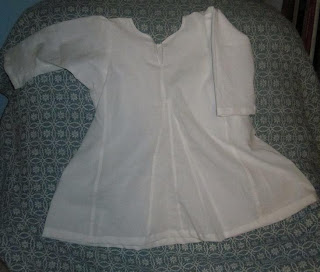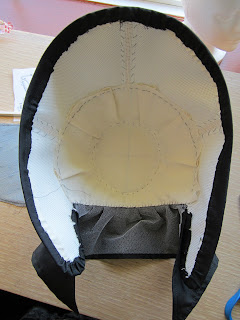WARNING: this post is rather comically graphic about female anatomy & function (or malfunction), if you are shy about this topic, go read one of my pretty dress posts instead.
If you have a giggling bladder, you may want to get a new pad before reading this.
 |
Roman de la Rose
(Psst...the book is all about sex) |
Getting lost down the rabbit hole of reenactor blogs is always fun. Welcome to my little corner of Wonderland.
This particular burrow twisted its way to the topic of women's undies in the 14th c. or rather the lack of evidence for them (which continues right up to the 1790's when someone finally bothered to mention them, unless you are Italian, then go for it since pre-Rome). It kept to the polite world of fashionable evidence* and what was considered right and proper for the time and place. All well and good, and possibly right... but I think on this topic maybe we should get a bit more personal, a bit more anatomical and a bit more honest about what girl-bits actually do.
*or lack thereof except for the German things which may or may not have
belong to a man or woman, the DNA tests were inconclusive.
I think underwear is like bras. Women with small busts will make the braless
argument (14th c.), and have good physical evidence to back it up, "Look! My A/B breasts are perfect for this time period! I look just like the paintings." Women who are
well-endowed can't imagine going without for extended periods of time - it HURTS,
and there is plenty of written evidence to suggest that many people used
bust support of some kind; be it camisoles, partlets, breast bags
(bras), bindings, supportive shifts, etc. sometimes referenced in art,
sometimes not.
 |
1411 Fountain of Youth
(look! skivvies! on a person with boobs!) |
Regarding underwear, drawers, trousers, leggings, etc.
The Period.
There is the old argument that says "they must have worn something at least once a month" which is valid, but can be answered with tampons* so as not to leave a red trail on the ground or stain one's shoes, clothes, furniture, etc... However, I want to take this beyond the pad/tampon sticking point and talk about the every day life facts of being the proud owner of occasionally non-cooperative and troublesome female bits - through sickness and health.
*for light flow folks who have never seen a clot in their lives...
Thighs.
Women who have slender thighs will say "you don't need drawers, they didn't wear them, go without,"
whereas women who chaff without leg protection will get a bit
testy* if they are told they can't wear something to protect their upper legs from their upper legs. Let's face it,
Lady Monkey Butt may be awesome today (for 30 steps), but it sure wasn't on the market in the 1400's.
*Murderous
I happen to be one of these unfortunate souls - my thighs have not parted ways since I was 8 yrs. old and got run over by the puberty truck. The last time I was able to walk around without a cotton lining between my legs I was in 2nd grade. I hated gym class because you had to wear shorts. Those stupid things would crawl up to my crotch within 5 steps, and here's the busty/hippy girl, trying to run around the track while simultaneously holding my boobs still, pulling out the frontal wedgie, praying I wouldn't get blisters and feeling them bloom with each step; looking like a damn fool and getting yelled at for being last because I was waddling across the finish line trying not to let my thighs move/touch/rub any more. No, your thighs don't get used to it; they just chafe. I tried it again a few times in college just to be interesting, and got rubbed red blisters with bloody abrasions that took weeks to heal with me walking around
trying to be bowlegged. It's funny, but I assure you, it's not fun.
A small piece of advice: don't even try to tell us girls with conjoined thighs that we should suffer for historic accuracy, or that our dusty counterparts did so either - no one is that stupid or masochistic. I could rest my case there, but being mostly English and not at all Italian it's not a strong historic argument - though it does cover body type needs quite well; which should end the reenacting discussion for any rational, thinking, compassionate person. For the love of all that is comfy, don't take my drawers away!
Personal Humidity.
Ladies with a drier
personal environment may say "you don't need underwear." Those who reside in the subtropics and employ panty liners to catch the copious amounts of mucus are not all that different from their ancestors. Personal humidity varies throughout the month, and person to person. Some people may never have a hint of moisture in their lives unless it's stained red... others have never seen a dry day. If you are one of the many ladies of a more damp persuasion, underwear and liners become quite critical - especially if coupled with wedded thighs and fewer than 4 layers of cloth.
Can you imagine walking around with runny boogers hanging out your nose
like that sticky toddler your used-to-be good-friend somehow spawned?
No? Then don't expect someone to walk around with that between their
legs. Let them have their personal tissues which need something to hold
them in place - like a pair of underwear, though I'm sure
someone will come up with some ridiculous contraption to deny the possibility of such a simple, logical, easy (historically available) solution.
Sex.
Yes, adults do it. It's how we get the snotty-nosed toddlers referenced above. Reproductive sex is messy. If you are lucky, it's only temporarily messy; but alas, this is reality and like all other fluids in the pelvic region, it can surprise you with ill-timing and astonishing amounts later in the day. Again, I reference the need for absorbent material on the outside. Sex was considered part of basic human health, which has thankfully made a return in modern medicine (curse the Victorians). The most common places you see women without underwear in Medieval, Renaissance & Baroque artwork? Pornography. Jokes. Porny jokes. Anywhere there is sex, there are naked bums.
Infections.
Yup, we all get them. One kind or another, one time or another, every female on the face of the planet is going to have a bad girl-bits day. Some are best treated with medicine, others with open air... but no matter what, medicine doesn't stay in. It comes out eventually. Preferably, it comes out when it's supposed to, which is in the bathroom. Usually it's when you stand up from the dinner table... then you get that funny look on your face and your husband says "what's wrong Honey?" and you have to sorta try to smile and say "nothing Dear" but the kids all think they just did something wrong and now your husband is wondering what you aren't talking about and.... just imagine that moment on bare thighs and the uncertainty of where that precarious gob is going to land... Draw whatever conclusions you like, but the fact is, things don't stay in.
Incontinence.
Many women suffer from
varying degrees of incontinence, which is quite natural after childbirth,
as one ages, has hormonal changes, gains weight, etc. I can't imagine visiting a friend in 16th c. England, being terrified to laugh or sneeze least my bladder let go all over their new imported oriental rug (which would probably be on the table, not the floor... but you take my meaning). Nor can I imagine soiling every dress I owned every day at least several times a day while going about my daily tasks. This doesn't rule that scenario out, but the fact is fabric was expensive. Silk doesn't like urine, while linen will easily tolerate it. A shift & petticoat are simply not enough to keep a 55 yr. old bladder's contents away from that damask when the human it resides in sneezes; but several layers of folded diaper linen, an absorbent weave often found in gong tower excavations,
are.
Urine cannot be caught by tampons, the anatomy just isn't right.
The moist squishy facts of being born with that particular body part is
that it leaks. It leaks blood, urine, mucus and various other
substances as life goes on. True then, true
now. For some women more than others.
As
a reenactor, I think it has to come down to comfort and feasibility.
If you are fine going without, go without. If you'll be crippled by
blisters and chaffing within 8 steps or have a wet spot on your skirts 30 minutes into the morning, please ignore the skeptics and wear something. Quite honestly, as much as I care about historic accuracy, anyone who is close enough to see that garment either needs to not care about your choice in undies or get kicked real hard with shoes that have metal bits built in.
In terms of history and evidence, if you want to find lady's underwear, look at what the
sermons are preaching
against and glance through the medical treatises on women's health,
you'll find a lot more than what is listed in the tailor's inventories.
Also look into funeral practices; personal items were routinely burned
or donated to charity without being listed individually, and while we
can't know exactly what was there, there is room for a reasonable
assumption (with caution).
 |
1475-1500 The World Turned Upside Down
Gender role reversals
German |
Caution: Don't take my reasoning as proof. There is scattered evidence, but it
is not generally accepted in the academic costume community. Take my
reasoning as logic based on biology; but also remember that modern logic
is not always logical in a historic context.
I'm not using the "if they'd have had it they'd have used it" argument. I want proof before marketing a product which is why I only carry women's drawers for post-1500 Italy and post-1800 for everyone else. What I'm saying is, you live now, today in
your body. If it comes down to a choice between perfect scholarly accuracy and being painfully crippled for a week by chaffed thighs, the thighs should win.
But I also think the thighs won then. People aren't stupid, and they won't suffer needlessly or cripple themselves when there is a simple solution available. There is absolutely
no logical reason to assume that women did not wear similar styles of underwear as men did when need or want dictated... after all, it was women who made the skivvies in the first place. It may or may not have been proper, popular or talked about in mixed company - other than in sermons where it was being preached against for hundreds of years - so why? If it wasn't done, it wouldn't have caused the controversy. In art, it's either satire or allegory, but that doesn't mean it didn't actually happen. Just as today, different women may or may not have worn that garment. Now, just as then, it's not anyone's business but your own.
(I sincerely hope that no one is deeply offended,
I did warn you... But I think it's important to address more than the menstrual cycle when talking about this garment and its function in historic context for once-living women).











































